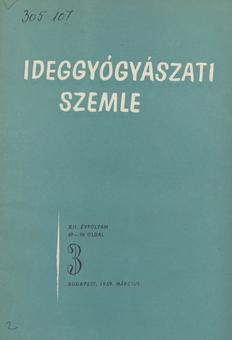The eLitMed.hu medical portal uses computer cookies for convenient operation. Detailed information can be found in the Cookie-policy.
Clinical Neuroscience - 1959;12(03)
Content
[Pathophysiological features of mental disorders in old age]
[We must admit that it is through histopathological research that we have arrived at the current classification of neurological diseases, or more precisely mental diseases, that occur in later life. The knowledge of the anatomical substratum has enabled us to distinguish arteriosclerotic dementia from dementias of old age. ]
[EEG in patients undergoing haemispherectomy]
[We report on serial EEG studies of five patients, 3 of whom had infantile hemiplegia maintaining epilepsy and oligophrenia, and 2 of whom underwent haemispherectomy for diffuse malignant glioma. Atrophic cerebrum was characterized by a flat polyrhythmic dysrhythmic curve with no electromic response to sensory stimuli and no sleep stages. Preoperative electromagnetic seizure potentials of the "intact" side may not be a contraindication to surgery if the electromic epileptiform discharges of the atrophic side are more pronounced. After surgery, the clinical manifestations of epilepsy also improve, and in favourable cases the patient is seizure-free (if the preoperative seizure potentials of the intact side are secondary discharges.) Removal of abnormal structures may ensure normalization of the abnormal electromagnetic activity of otherwise intact preoperative images. ]
[Psychopathological changes in chronic schizophrenic patients under LSD intoxication]
[In a chronic schizophrenic patient, a series of LSD experiments convinced us that LSD intoxication did not change the patient's underlying symptoms. The LSD psychosis, which could be induced in a healthy individual, combined with the patient's underlying symptoms. Within the merged picture, however, we also observed a modifying effect of LSD on the basic psychosis, which was manifested in changes in extensity and intensity without a qualitative difference. Increased LSD tolerance on successive days of administration has been reported in the literature (L. S. Cholden: in schizophrenics; H. Ishell: in narcomaniacs). Our studies confirm the experimental results of IV. A. Stoll and Anderson and Rawnsley. Toxic symptoms were neither quantitatively nor qualitatively proportional to the dose and the patient's baseline symptoms were also dose-independently enhanced or attenuated. In the development of model psychosis, the interacting forces of several constellative factors (changes in the dose administered, biological and psychopathological status, and experimental situation) must be taken into account. ]
[The issue of schizophrenic thinking disorder]
[We attempted to analyse the symptoms and behaviour of a schizophrenic patient in the light of normal psychological criteria and psychopathological research findings. In our patient, besides a relative retention of emotional functions, a very advanced formal disturbance of thinking was observed. We investigated his performance in a specific situation and assessed this performance in such a way that the retention of emotional functions allowed for a relatively good performance. Moreover, we attempted to justify the failure to perform relatively well by the retained but irregular emotional reactios. In particular, we wished to emphasise the importance of using occupational therapy in appropriate cases, in the sense that it is perhaps permissible to generalise that in cases showing relative intactness of emotional life it may be attempted, all the more so since, as our case illustrates, abandonment of regular employment, even in such cases, results in a deepening of the disorder of thinking, i.e., progression of the pathology.]
[Report on 2 months in the Republic of Romania]
[The author reports on his experience of 2 months in the Republic of Romania.]
[Vascular effects of sleep and nicotinic acid]
[After reviewing the literature on the vascular response to nicotinic acid, the author thought it appropriate to examine the influence of a fundamental central function, sleep, on what was previously thought to be a purely peripheral response.]
1.
Clinical Neuroscience
[Headache registry in Szeged: Experiences regarding to migraine patients]2.
Clinical Neuroscience
[The new target population of stroke awareness campaign: Kindergarten students ]3.
Clinical Neuroscience
Is there any difference in mortality rates of atrial fibrillation detected before or after ischemic stroke?4.
Clinical Neuroscience
Factors influencing the level of stigma in Parkinson’s disease in western Turkey5.
Clinical Neuroscience
[The effects of demographic and clinical factors on the severity of poststroke aphasia]1.
2.
3.
4.
5.



